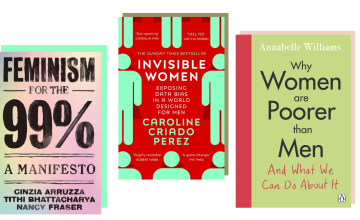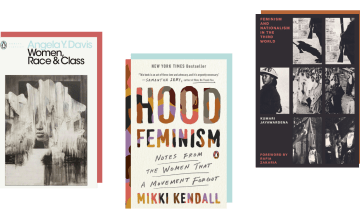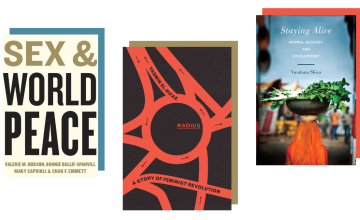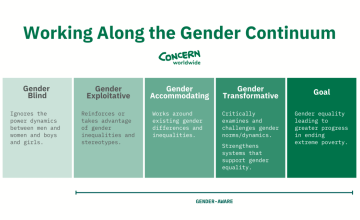
Read our 2023 annual report

Knowledge Hub
Every March, we find tables in bookstores crowded with books about gender equality. With so many options, it’s difficult to know where to start.
In honour of International Women’s Day, we’ve put together a list of 12 books that cover both general feminism and gender parity, to books that examine intersectional issues—many of which are the same issues Concern addresses in its work every day. Read on for our recommendations.

Cinzia Arruzza, Tithi Bhattacharya, and Nancy Fraser: Feminism for the 99%: A Manifesto
This short but impactful book, co-authored by three of the organisers of the International Women’s Strike US, examines feminism in the 21st century with an aim toward “reorient[ing] feminist struggles in a time of political confusion.” In under 100 pages, Arruzza, Bhattacharya, and Fraser tackle corporate “lean in” feminism, gender-based violence, capitalism, climate change, poverty, healthcare, and more — many of the same issues that Concern sees intersecting with gender equality every day in our work.
Caroline Criado Perez: Invisible Women: Exposing Data Bias in a World Designed for Men
Some gender equality facts and figures that you may not know: Most offices are five degrees too cold for women. Women are 50% more likely to be misdiagnosed following a heart attack—and 50% more likely to be seriously hurt in a car crash. Google’s speech-recognition software is 70% more likely to understand men than women, and fitness monitors can underestimate steps taken doing housework and pushing a pram by as much as 74% (that last part isn’t exclusive to women, but as we know domestic labour falls on their shoulders far more often).
All of this is due to what Caroline Criado Perez calls a gender data gap, which bases design and decisions on data that often excludes women and nonbinary people from the equation. “The gender data gap isn’t just about silence,” Criado Perez writes. “These silences, these gaps have consequences.”
Annabelle Williams: Why Women are Poorer than Men (And What We Can Do About It)
We know that when women thrive, economies thrive. When 10% more girls in a given country attend school, that country’s gross domestic product increases by an average of 3% — which can make a huge difference in a developing economy. So why do we continue to have an economic gap between women and men? Annabelle Williams addresses this head-on in Why Women Are Poorer Than Men, examining issues like homelessness, financial autonomy, the gender pay gap, and why there are more men named Dave running the UK’s top 100 companies than there are women altogether.

Angela Davis: Women, Race & Class
A landmark book published four decades ago, American activist and writer Angela Davis’s examination of gender issues through the intersections of race and class continues to resonate, highlighting the ongoing inequities faced within feminist movements by women of colour and lower incomes. As Davis shows in her historical analysis of women’s suffrage, these are issues that have persisted for centuries: “The leaders of the women's rights movement did not suspect that the enslavement of Black people in the South, the economic exploitation of Northern workers and the social oppression of women might be systematically related.”
Mikki Kendall: Hood Feminism: Notes from the Women that a Movement Forgot
An excellent companion to Davis’s Women, Race & Class is Mikki Kendall’s 2020 collection of essays which build on many of the themes Davis outlined in 1983, contextualising them in the 21st century. “One of the biggest issues with mainstream feminist writing has been the way the idea of what constitutes a feminist issue is framed,” Kendall writes.
“We rarely talk about basic needs as a feminist issue. Food insecurity and access to quality education, safe neighbourhoods, a living wage, and medical care are all feminist issues. Instead of a framework that focuses on helping women get basic needs met, all too often the focus is not on survival but on increasing privilege. For a movement that is meant to represent all women, it often centres on those who already have most of their needs met.”
Kumari Jayawardena: Feminism and Nationalism in the Third World
First published in 1986, the title of Sri Lankan author Kumari Jayawardena’s book may seem outdated, but its content is anything but. Her study of feminist movements in 11 countries across Asia and the Middle East—Egypt, Iran, Türkiye, India, Sri Lanka, China, Japan, Korea, the Philippines, Vietnam, and Indonesia—gives a comprehensive portrait of how colonialism shaped gender issues in colonised countries, especially through policy and law. While each of these movements is distinct in their own right, Jayawardena stresses that they are also interconnected, generating a whole greater than the sum of its parts. The feminist bible Ms. Magazine named it one of the top 20 feminist classics.

Valerie M. Hudson, Bonnie Ballif-Spanvill, Mary Caprioli, and Chad F. Emmett: Sex and World Peace
Speaking of national policy: Valerie Hudson, Bonnie Ballif-Spanvill, Mary Caprioli, and Chad F. Emmett reveal the link between gender-based violence and conflict: “The very best predictor of a state’s peacefulness is its level of violence against women. Even democracies with poor physical security for women are less peaceful than democracies with good physical security for women. The greater the inequity in family law concerning women, the less stable and the less peaceful the nation. And the less willing a country is to enforce laws protecting women within its own borders, the less likely it is to comply with international treaty obligations.”
This is especially important as women and girls are even more vulnerable in conflict settings. Deeply researched and teeming with data, Hudson, Bailiff-Spanvill, Caprioli, and Emmett’s text also offers solutions for how we might move forward towards a safer and more equitable world.
Yasmin El-Rifae: Radius: A Story of Feminist Revolution
Sex and World Peace is an excellent resource, but if you’re looking for a more personal, narrative-driven book on the topic of political instability and gendered violence, Yasmin El-Rifae’s account of the 2011 Egyptian Revolution—particularly its immediate effect on women is riveting and illuminating. El-Rifae was a journalist in Cairo when the Arab Spring protests began in 2011, and resurged in 2012. Between 2012 and 2013, she also found herself as an organizer of Opantish — Operation Anti-Sexual Harassment — which grew out of the increased incidents of sexual violence against female protesters.
El-Rifae weaves her own experiences together with reporting done among other Opantish activists to create a gripping portrait of on-the-ground emergency response work and the threats women face during times of political shift and social change (times that have only become more frequent 10 years on).
Vandana Shiva: Staying Alive: Women, Ecology, and Development
Much like conflict, women and climate change are an intersectional issue. There are several books on ecofeminism to choose from, but Indian environmental activist and food sovereignty advocate Vandana Shiva’s is especially strong for how it links gender inequality to the climate crisis through the idea of “maldevelopment”—development projects that run counterintuitive to indigenous knowledge and practice, many of which have historically viewed nature as “unproductive” and agriculture as synonymous with poverty.
Women, she says, are a key link in solving the challenges and effects of climate change. “The recovery of the feminine principle,” she argues, “allows a redefinition of growth and productivity as categories linked to the production, not the destruction, of life. It is thus simultaneously an ecological and a feminist political project which legitimises the way of knowing and being that create wealth by enhancing life and diversity.”

Anushay Hossain: The Pain Gap: How Sexism and Racism in Healthcare Kill Women
Growing up in Bangladesh, Anushay Hossain felt she had lucked out when she became pregnant while living in the United States: The maternal mortality rate in Bangladesh as of 2023 is 156 deaths per 100,000 live births, while in the United States, as of 2021, it’s 32.9 deaths per 100,000 live births.
However, Hossain almost became one of those 32.9 per 100,000 when, after 30 hours of labour, her epidural slipped, she had a fever of 104 degrees Fahrenheit, and her doctors performed an emergency C-section. “Despite my years as a feminist policy analyst on Capitol Hill, working on global health legislation, it took almost dying on the delivery room table for me to see that pregnancy-related deaths are not merely casualties of the so-called developing world,” she writes in the introduction to The Pain Gap. If you’re keen to learn more about the deadly effects of gender bias in healthcare, this book covers the topic from both a personal and national perspective, while also factoring in compounding factors like race and disability. Though much of its focus is on the American healthcare system, many of the truths are universal.
Shon Faye: The Transgender Issue: An Argument for Justice
All too often the discussion of gender equality falls along a simple binary between men and women. However, this ignores the spectrum of gender identities—all of which are marginalised in most societies at the expense of cisgendered males. In the United States, research from the Williams Institute in 2019 shows that 29% of all transgendered adults are living in poverty (higher than the average even for the broader LGBTQIA+ community). Despite this high number, a later report by the Williams Institute in 2021 estimates that only 0.5% of the US adult population (1.3 million people) and 1.3% of the US youth population (300,000 people) identify as trans.
Shon Faye tackles a similar disparity in The Transgender Issue, focusing on her home country, the United Kingdom, where 1% of the population is estimated to be trans. Despite this, they face an outsized, vocal opposition, while also being denied their own voice in the conversation. She explores this dynamic across many of the realities of daily life, including work, housing, and healthcare.
Michael Kaufman: The Time Has Come: Why Men Must Join the Gender Equality Revolution
Gender equality isn’t just a women’s issue, and engaging male allies to challenge harmful norms and stereotypes is a key element of fostering lasting and meaningful change. Michael Kaufman, cofounder of the White Ribbon Campaign and an advisor on gender equality to the United Nations (among others), makes the case for this in The Time Has Come. He examines many of the gendered norms that persist around the world, how even the most harmful of these stereotypes lead to violence against women, and what we can do to make changes both at home and in the world.
Concern and gender equality
The United Nations identifies gender equality as Goal #5 of its 17 Sustainable Development Goals to hit by 2030. To reach this, our approach at Concern is to address the root causes of gender disparity. Many of these causes are similar to the factors that perpetuate global poverty and hunger.

The closer we can get to work that’s transforming gender inequality versus simply being aware of it, the closer we can get to actual gender equality.
You can support our work by donating below.





